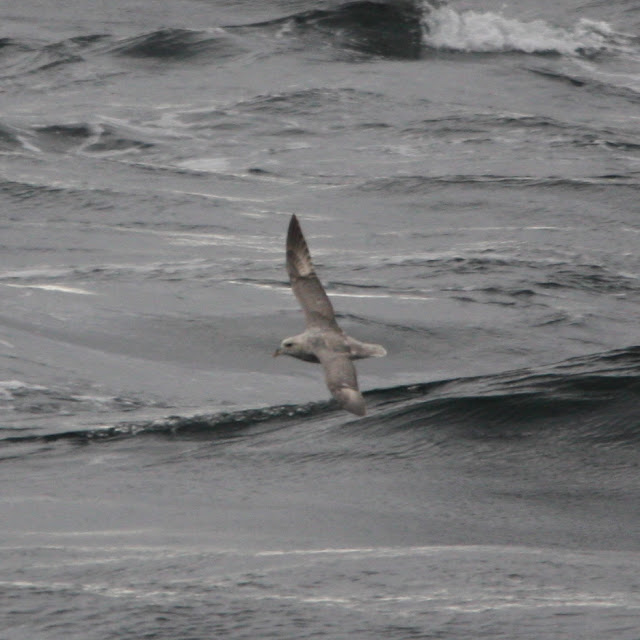Tuesday, 28 May 2013
Dark Pomarine Skua (with spoons)
While I was on Westray last week phenomenal numbers of Long-tailed Skuas were passing by in the NW gale. Seawatching in those conditions is not the recommended activity for a party of non-birding teenagers so despite walking the headlands in some outlandish May weather I was unable to watch the long-tailed sea-sprites pass by. Instead I contented myself with a single melanistic (dark morph) Pomarine Skua from the Westray to Kirkwall ferry. Well, I was pretty excited about this at least. No pics of the Basking Shark seen briefly on the same journey unfortunately.
Monday, 27 May 2013
Blue Fulmar in the Pentland Firth
I have been lucky enough to be visiting various of the Orkney islands for the past fortnight. Always a fantastic archipelago - packed with outstanding wildlife, archaeology and scenery - the weather was not the kindest this year and as it was a work visit I was unable to make the most of the birding on offer. For example I missed out on the phenomenal passage of Long-tailed Skuas last week despite being on Westray at the time... not to mention the Garganeys, White-billed Diver, Red-backed Shrikes, etc. Next time?...
Here is my best sighting of the fortnight - a blue Fulmar - an intermediate/dark morph of our Northern Fulmar. Only my fourth sighting of this form, I was pleased to get these record shots as the bird passed the ferry back to mainland Scotland, especially since I failed to get any shots of a probable at Seafield earlier this year.
Monday, 6 May 2013
Willow Warbler, Chiffchaff and Wood Warbler in Edinburgh
 |
| Wood Warbler giving shiver-song in Duddingston yesterday |
I have managed to photograph these three species of Phylloscopus (leaf-searching) warbler in Edinburgh over the last few days. Of course, the Willow Warbler and Chiffchaff are common in the wooded and scrubby parts of the city at this time of year. Yesterday's Wood Warbler was a little more unexpected. Singing birds are no problem to identify - as Gilbert White famously noted in describing the three species as Laughing Willow-wren, Chif-chaf and Shivering Wilow-wren.
 |
| Yesterday's Wood Warbler showing off its primary projection and yellow throat |
 |
| A Willow Warbler at Duddingston yesterday had the pale washed out appearance of a more northerly bird. Long primary projection obscured... |
 |
| Note short primary projection compared to tertial length on this Chiffchaff photographed at Blackford Pond |
 |
| Pale eye ring, dusky cheek and (in life) tail dipping behaviour all good Chiffchaff features |
Sunday, 5 May 2013
Wood Warbler at Duddingston
I grew up in North Wales listening to the song of Wood Warblers through my bedroom window. After moving to Edinburgh I am pretty sure that I heard them singing in Blackford Glen and Craiglockhart Hill nearly 20 years ago and I have bumped into one or two on the East coast during migration periods. But when I came to compile my Lothian self-found list a couple of years ago I found that I could not recall the finding any particular individual Wood Warbler. So that species remained unchecked... until today.
The Wood Warbler, of course, has suffered a considerable decline in that time. It no longer sings in many woods that previously held them in Wales, and the situation is no different in Scotland. Today's bird, heard singing for an hour in Duddingston, will be passing through to some forest further North and West for it no longer breeds in Lothian.
A very beautiful species, with a real tropical look or that of a New World wood warbler, perhaps...
Labels:
Edinburgh,
Wood Warbler
Isabel: dilution mutant Herring Gull at Seafield again
I spent a couple of hours checking the gulls at Seafield today. While it was the Lesser Black-backed Gulls that predominated on St Margaret's Loch en route, at Seafield it was almost entirely Herring Gulls at the recycling centre. The isabel dilution mutant was the clear highlight in among the latter. It showed on three occasions and posed well on the ground as well as in flight. Very nice, thank you - I had hoped for better views and was not disappointed.
Interesting that it appears to already have dropped a couple of innermost primaries. Could this early moult may be a result of the fragility of the unpigmented feathers?

Interesting that it appears to already have dropped a couple of innermost primaries. Could this early moult may be a result of the fragility of the unpigmented feathers?

Wednesday, 1 May 2013
Malawi Wagtails

Watching the wagtails along the coast at the weekend reminded me that there still are plenty of Malawi bird shots that I have yet to blog. Wagtails are always entertaining birds and these two species, African Pied Wagtail and the Mountain Wagtail are also strikingly attractive birds. Essentially the ecological equivalent of the Pied and Grey Wagtails south of the Sahara, I photographed the African Pied Wagtail on the shores of Lake Malawi and the Mountain Wagtail on a stream on Mount Mulanje.
Subscribe to:
Comments (Atom)






















